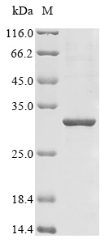This recombinant human neuronal acetylcholine receptor subunit alpha-7 (CHRNA7) comes from an E.coli expression system and spans amino acids 23 to 230—a partial protein length. An N-terminal 6xHis-tag is included to make purification and detection more straightforward. SDS-PAGE analysis shows the product achieves greater than 85% purity, which should provide reliable results for research applications. Endotoxin levels have been kept low to allow safe use across different experimental conditions.
The neuronal acetylcholine receptor subunit alpha-7 appears to be a key component of nicotinic acetylcholine receptors, which handle fast synaptic transmission in the central nervous system. It seems to play an important role in controlling neurotransmitter release and has been linked to cognitive processes like learning and memory. Researchers studying synaptic function and neurological disorders are likely to find this protein particularly interesting.
Potential Applications
Note: The applications listed below are based on what we know about this protein's biological functions, published research, and experience from experts in the field. However, we haven't fully tested all of these applications ourselves yet. We'd recommend running some preliminary tests first to make sure they work for your specific research goals.
Based on the provided information, the recombinant Human CHRNA7 is expressed in E. coli, a prokaryotic system that is generally unsuitable for producing functional eukaryotic membrane proteins like CHRNA7. CHRNA7 is a complex receptor subunit that requires precise folding, post-translational modifications (e.g., glycosylation), and proper assembly into pentameric structures for bioactivity. The protein is expressed as a partial fragment (23-230aa), which likely lacks critical transmembrane and intracellular domains, further reducing the probability of correct folding. The N-terminal 6xHis tag may also interfere with native conformation. Since activity is unverified, the protein cannot be assumed to be correctly folded or bioactive. Experimental validation is essential to confirm folding and function.
1. Antibody Development and Validation
This recombinant CHRNA7 fragment (23-230aa) could work well as an immunogen or antigen for creating specific antibodies against the neuronal acetylcholine receptor subunit alpha-7. The N-terminal 6xHis tag makes purification easier and allows for straightforward immobilization during antibody screening assays. The extracellular domain region that's expressed probably contains important epitopes that antibodies would recognize. Given the greater than 85% purity, this protein should be suitable for immunization protocols and follow-up antibody characterization work. However, if the protein is misfolded, antibodies may primarily recognize linear epitopes and might not bind the native, full-length CHRNA7 in physiological contexts. Validation against native CHRNA7 from neuronal tissues is recommended.
2. Protein-Protein Interaction Studies
Researchers might use this recombinant CHRNA7 fragment in pull-down assays to find potential binding partners or other interacting proteins. The N-terminal 6xHis tag makes it simple to attach the protein to nickel-based resins for affinity purification experiments. However, if CHRNA7 is misfolded, it may not interact physiologically with binding partners (e.g., other receptor subunits or ligands), leading to non-specific or false interactions. The expressed region may lack key domains required for native interactions. This application should be considered high-risk without prior folding validation.
3. ELISA-Based Binding Assays
The 6xHis-tagged CHRNA7 protein can be attached to ELISA plates for quantitative binding studies with different ligands, small molecules, or other proteins. The tag allows researchers to orient the protein properly using anti-His antibodies or nickel-coated surfaces. However, if the protein is misfolded, binding sites may be altered, resulting in inaccurate kinetics or specificity data. The partial fragment may not fully represent the native receptor's binding properties. This application requires confirmation of correct folding before reliable use.
4. Biochemical Characterization and Stability Studies
This recombinant protein appears suitable for detailed biochemical analysis, including thermal stability testing, pH tolerance assessment, and structural integrity evaluation. The relatively high purity (>85%) makes it a good candidate for biophysical characterization methods such as dynamic light scattering, circular dichroism spectroscopy, and analytical ultracentrifugation. These studies would likely provide valuable information about how this CHRNA7 domain folds and maintains stability when expressed in E. coli. This application is appropriate even if the protein is misfolded, as it directly assesses folding quality.
Final Recommendation & Action Plan
Given the high likelihood of misfolding due to E. coli expression and the partial nature of the protein, it is critical to first validate the protein's conformation and bioactivity before any functional applications. Recommend performing biophysical characterization (e.g., circular dichroism for secondary structure, size-exclusion chromatography for oligomeric state) to assess folding. If resources allow, conduct functional assays (e.g., binding to known ligands like α-bungarotoxin) to confirm activity. For antibody development, the protein can be used immediately, but resulting antibodies should be validated against native CHRNA7. Avoid interaction or binding studies until folding is confirmed. If misfolding is detected, focus on applications like biochemical characterization or as a control for folding studies. Always include appropriate controls, such as full-length CHRNA7 from mammalian expression systems, for comparative purposes.






